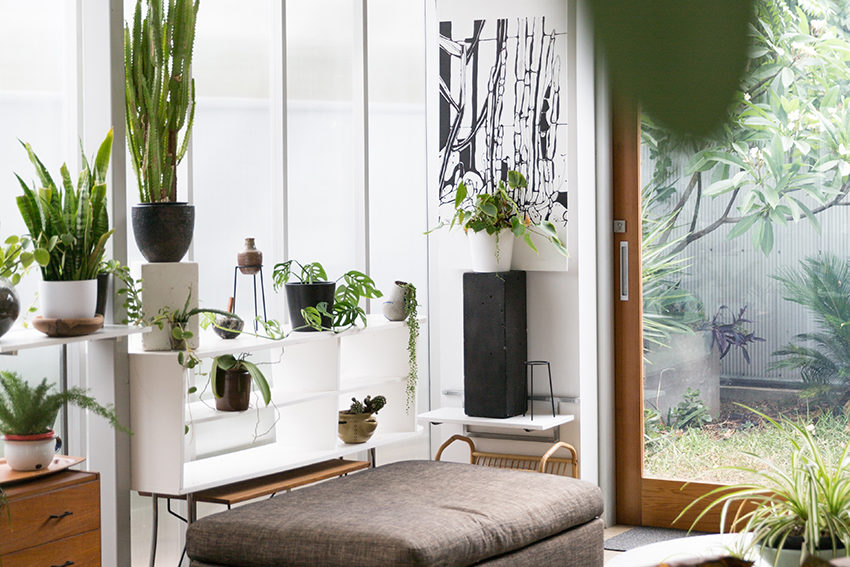A.nouk Studio's Adaptive Style

Lovers of Bowden’s upcycled urban province Plant 4 will find much to please the eye at Joslin Koolen’s A.nouk Studio on Byron Place in the western corner of the CBD.
Indeed, Koolen’s business is co-located with partner Ashley Halliday’s architecture and interior design studio – which won the 2017 Australian Institute of Architect’s top Sustainability Award for the design of Plant 4 Bowden, formerly the site of electronics manufacturer Clipsal.
Adaptive reuse is just one of the passions of this talented pair. They’re also doyens of multipurpose space, plant-based living, bespoke design, local value and design leadership. They purchased the Byron Place block in 2005 and have created a light-filled, flexible live/work space on two levels, where they work with clients ranging from Kangaroo Island’s new air terminal to The Stirling Hotel (owned by Hills-based hospitality purveyors The Matthews Hotel Group). Koolen and Halliday are also keen collaborators with other artists, designers, and makers; with current partners including renowned interior designer Claire Kneebone.
 Showing The Adelaide Review through the ground floor studio to a stylish, comfortable lounge space, Koolen explains that they “wanted the space to allow users to move easily in and out from privacy to a more communal environment if they want to”.
Showing The Adelaide Review through the ground floor studio to a stylish, comfortable lounge space, Koolen explains that they “wanted the space to allow users to move easily in and out from privacy to a more communal environment if they want to”.
“And I think that’s the key really with any kind of built environment – making it as inclusive as possible,” she says.

Inclusivity is an important value for both Halliday and Koolen, who complement each other with artistic and architectural training; working with “tier, tone and texture” as Koolen puts it. While Halliday is focussed on building-scale design, Koolen does “the finishing touches, to humanise the space”.
A.nouk provides made to spec object art, plant styling and spatial installation services by appointment. Koolen notes that demand for such services is increasing: “people more and more, for example, want plant life around them on a 24-hour basis, not just when they go home.”
 To be sure, the rise of a silicon-based economy and a globalised workforce means that work and living spaces are changing in their form and function. Are Koolen and Halliday’s flexible, bespoke building and collaborative, design-oriented work style reflective of that change coming to Adelaide?
To be sure, the rise of a silicon-based economy and a globalised workforce means that work and living spaces are changing in their form and function. Are Koolen and Halliday’s flexible, bespoke building and collaborative, design-oriented work style reflective of that change coming to Adelaide?
“Definitely,” says Halliday, as their dog, Myf, bounces in to meet us. Indeed, this is also an animal-friendly workplace, and the blue heeler rescue dog is another member of the
team and a much-loved local fixture, often catching the eye of passers-by from her favourite spot on the second floor.

“While a lot of people from our generation left Adelaide, we took the opportunity to stay,” Halliday notes. Formerly a Principal at Hassell, he decided to shift into his own practice when he became “more interested in building and growing something than maintaining it.”
 Today, the couple sees great potential for their city to champion home-grown design leaders; a potential that is currently in danger of being overlooked when it comes to commissioning buildings and interiors. “People and firms from interstate are often the ones leading big architectural projects in Adelaide,” Halliday says.
Today, the couple sees great potential for their city to champion home-grown design leaders; a potential that is currently in danger of being overlooked when it comes to commissioning buildings and interiors. “People and firms from interstate are often the ones leading big architectural projects in Adelaide,” Halliday says.

Koolen and Halliday both believe that a risk-averse reliance on leadership from interstate affects the confidence of Adelaide’s own creators. This, Koolen says, also encourages skilled, visionary people to seek work in other states and cities when instead, they could be part of “galvanising Adelaide’s identity in a time of upheaval” and transition to the new global economy.
“It gets harder to stay when you see opportunities go over the border, or only to big companies and developers.”
But stay they have, and the design duo intend to continue thinking and working on their chosen city’s creative potential from the elegant building on Byron Place.
A.nouk Studio
20 Byron Place, Adelaide
anoukstyle.com.au
ashleyhalliday.com
Photography: Sia Duff